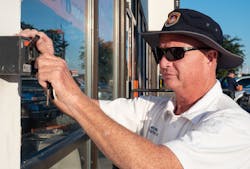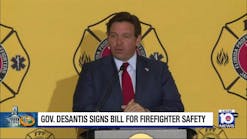Cancer-Risk Reduction: Control What You Can Control
There is considerable conversation, policy development and funding appropriation for post-fire decontamination, second sets of gear and laundering facilities in regard to cancer prevention. However, the individual firefighter has a role, too, and that focuses on risk reduction and early detection. These strategies might not be sexy, but they are scientifically proven, and they are areas that are within the control of each and every member.
Legendary UCLA basketball coach John Wooden is quoted as telling his players to focus all of their effort in what they have the power to control. NBA Hall of Famer Kevin Garnett follows that concept with, “At the end of the day, you’re responsible for yourself and your actions, and that’s all you can control. So rather than be frustrated with what you can’t control, try to fix the things you can.”
Professor Keith Argenbright, who is the director of the Moncrief Cancer Center Institute, believes that these principles translate well to the conversation of firefighting and reducing risks of cancer in the fire service. “Firefighters may not be able to control the associated risks from the profession of firefighting, but they can control what they can control, and there’s plenty that they can control.”
Modifiable risk factors
Early detection. Early detection of cancer remains one of the most important parts of risk-reduction strategies. Most departments have some form of annual physical examination that aligns with NFPA standards. These evaluations should be enhanced beyond typical occupational medical physicals that are completed by most healthcare institutions. They should include earlier and more aggressive screenings than those that are recommended by the American Cancer Society, because firefighters are at such a high risk and are experiencing cancers at younger ages than the general public.
A comprehensive skin exam should be included. Vaccine management should be encouraged. An assessment of a firefighter’s overall wellness should include evaluation for/of stress, fatigue, diet, substance use, etc. A sponsored program should be available to refer members regarding diet, exercise, smoking cessation, stress reduction, etc.
Many types of programs are available that enhance human performance and preparedness. However, firefighters shouldn’t be left on their own to find these referrals. Such programs should be vetted for relevance, effectiveness and participation. The members of the department must be included in the development of these programs, otherwise they risk becoming useless and nonimpactful.
Skin protection. Firefighter risk of melanoma is greater than that of the general population, and, generally, it occurs in firefighters at younger ages than it does in the general population.
The risks that are associated with melanoma can be reduced by limiting exposure to the sun, wearing long-sleeved shirts when possible and applying sunscreen.
The Fort Worth, TX, Fire Department recently changed its uniform policies to allow for a standard baseball cap to be recognized as part of the authorized uniform simply to encourage head coverings, and to make sunscreen available to fire stations in their station inventory.
Firefighters should be encouraged to use broad-spectrum sunscreen even on days when clouds dominate the sky. It should be of a sun protection factor (SPF) of at least 30 and be applied every two hours on a normal basis and more frequently when skin is affected by profuse sweating. Application can reduce the risk of squamous cell carcinoma or melanoma by as much as 50 percent, various reports indicate.
It should be noted that there has been concern regarding cancer and the ingredient benzene in some sunscreen products. However, there is no scientific evidence that links the use of sunscreen with cancer, according to MD Anderson Cancer Center. However, there is plenty of science to support the relationship between ultraviolet (UV) rays from the sun and cancer.
Diet. There are many health benefits from a healthful diet, and a reduction in the risk of cancer is one of them. Diets that are based on fruits, vegetables and plant sources, such as grains and beans, are encouraged. Additionally, healthful fats, olive oils and fish are encouraged to be incorporated into a diet to reduce risk.
There is some evidence that a high intake of processed meats can increase your risk of cancer and should be limited.
Eating lighter meals that include foods that are lower in calories while limiting the intake of sugar often is a recommendation of cancer prevention theorists.
Exercise. A defined exercise program that has a goal of maintaining a healthful weight reduces your risk of cancer and makes your body capable of defending the insult that it takes if you develop cancer.
Tobacco and alcohol use. This isn’t a new finding, nor should it be a surprise to firefighters: The use of tobacco products increases the risk of cancer substantially and should be discouraged. Meanwhile, alcohol should be used in moderation, because it increases your risk of certain cancers in conjunction with the amount that you regularly consume.
Sleep/fatigue management—Although the profession of firefighting is changing, what’s constant is long shifts for multiple days a month and the stress and fatigue that places on our body. Over time, an increased risk of chronic fatigue syndrome (CFS) is possible. Multiple studies relate CFS to a reduction in immune activation and to infections that possibly are linked to non-Hodgkin’s lymphoma.
Although more studies of the subject certainly are needed, limited research currently describes increases in heart rate, catecholamine release and inflammatory cytokine production in firefighters who are under stressful situations, which potentially affect immune response.
Virus transmission, vaccinations
The hepatitis B virus (HBV) and hepatitis C virus (HCV) attack the liver, and the body’s immune system is unable to counter the effects. HCV has been associated with an increased risk of cancers in older populations. HCV can cause hepatocellular carcinoma and other subtypes of non-Hodgkin’s lymphoma. HCV is easily transmitted and is found in multiple population subsets that fire and EMS serve.
The vaccine for HBV involves its injection in multiple doses over approximately 24 months. Currently, there isn’t an approved vaccine for HCV, although there has been promising recent research.
Human papillomavirus (HPV) is any of a group of viruses that’s passed through skin-to-skin contact and falls into low- and high-risk groups. Although most HPV infections don’t cause cancer, high-risk HPV viruses are linked to several types of cancers, and they increase risks to both men and women, including cervical, oropharyngeal, anal, penile and vaginal cancers.
The vaccine for HPV, which originally only was for women but later was made available to men, is recommended primarily to prevent HPV infection and to reduce the associated cancer risks from infection. The vaccine can be administered to people who are as old as in their 40s.
Personal accountability
The risk of cancer in the fire service is real. As firefighters, we are fortunate to have fire chiefs, fire equipment manufacturers, politicians, and medical professionals who are working to help to reduce the risks of cancer and to protect us and our families from the devastating effect of cancer that’s associated with our profession. We have the responsibility to modify our behaviors in an attempt to control the areas that we can control, to reduce our risks of cancer, and to maintain our health throughout a difficult career and into retirement.
Fire chiefs who are developing cancer-risk-reduction policies should challenge outdated principles that might help to reduce the risk of cancer in the fire service. Policies that limit head coverings, such as baseball caps, because they are “unprofessional” should be changed to allow them to be worn while the individual is outdoors to reduce risk from UV rays. Sunscreen should be added to station ordering systems.
Although many departments across the country have a policy that forbids members from being in the bunk before certain hours, there is scientific evidence that indicates that, when the work and training requirements are met for the day, a rest period should be encouraged and supported to reduce the risk of cancer.
Although firefighters might not be able to individually manage the politics around presumption and risk-reduction strategies, they do have the opportunity to reduce their personal risk through behavior modification strategies and personal accountability. They also have the opportunity to talk to, teach and encourage each other to use these simple risk-reduction strategies that are in their control. Personally, I can’t think of a better way to remember and respect those brothers and sisters who we lost to cancer than to control what we can control in the fight against occupational cancers in our profession.

Jim Davis
Jim Davis is the fire chief of the Fort Worth, TX, Fire Department. Previously, he worked for 30 years for the Columbus, OH, Division of Fire, where he rose to the rank of assistant fire chief of training and EMS and then of administration. Davis is a registered nurse who has a critical care background in ER, ICU and toxicology. He sat on Ohio’s State Board of Emergency Medical, Fire and Transportation Services, including two years as chair. As a board member of the Central Ohio Trauma System, Davis participated in the regionalization approach to disaster and trauma care. He currently sits on the boards of the Tarrant County 9-1-1 System and MedStar Mobile Healthcare. Davis holds a master’s degree in business of operational excellence from The Ohio State University and a doctorate in organizational learning from the University of Pennsylvania Chief Learning Officer Program.






